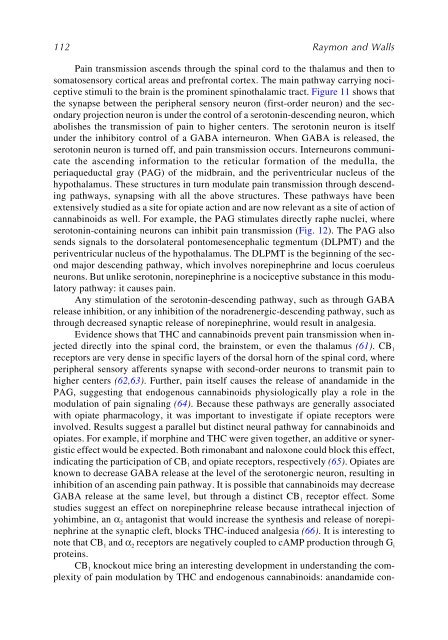Marijuana and the Cannabinoids
Marijuana and the Cannabinoids
Marijuana and the Cannabinoids
Create successful ePaper yourself
Turn your PDF publications into a flip-book with our unique Google optimized e-Paper software.
112 Raymon <strong>and</strong> Walls<br />
Pain transmission ascends through <strong>the</strong> spinal cord to <strong>the</strong> thalamus <strong>and</strong> <strong>the</strong>n to<br />
somatosensory cortical areas <strong>and</strong> prefrontal cortex. The main pathway carrying nociceptive<br />
stimuli to <strong>the</strong> brain is <strong>the</strong> prominent spinothalamic tract. Figure 11 shows that<br />
<strong>the</strong> synapse between <strong>the</strong> peripheral sensory neuron (first-order neuron) <strong>and</strong> <strong>the</strong> secondary<br />
projection neuron is under <strong>the</strong> control of a serotonin-descending neuron, which<br />
abolishes <strong>the</strong> transmission of pain to higher centers. The serotonin neuron is itself<br />
under <strong>the</strong> inhibitory control of a GABA interneuron. When GABA is released, <strong>the</strong><br />
serotonin neuron is turned off, <strong>and</strong> pain transmission occurs. Interneurons communicate<br />
<strong>the</strong> ascending information to <strong>the</strong> reticular formation of <strong>the</strong> medulla, <strong>the</strong><br />
periaqueductal gray (PAG) of <strong>the</strong> midbrain, <strong>and</strong> <strong>the</strong> periventricular nucleus of <strong>the</strong><br />
hypothalamus. These structures in turn modulate pain transmission through descending<br />
pathways, synapsing with all <strong>the</strong> above structures. These pathways have been<br />
extensively studied as a site for opiate action <strong>and</strong> are now relevant as a site of action of<br />
cannabinoids as well. For example, <strong>the</strong> PAG stimulates directly raphe nuclei, where<br />
serotonin-containing neurons can inhibit pain transmission (Fig. 12). The PAG also<br />
sends signals to <strong>the</strong> dorsolateral pontomesencephalic tegmentum (DLPMT) <strong>and</strong> <strong>the</strong><br />
periventricular nucleus of <strong>the</strong> hypothalamus. The DLPMT is <strong>the</strong> beginning of <strong>the</strong> second<br />
major descending pathway, which involves norepinephrine <strong>and</strong> locus coeruleus<br />
neurons. But unlike serotonin, norepinephrine is a nociceptive substance in this modulatory<br />
pathway: it causes pain.<br />
Any stimulation of <strong>the</strong> serotonin-descending pathway, such as through GABA<br />
release inhibition, or any inhibition of <strong>the</strong> noradrenergic-descending pathway, such as<br />
through decreased synaptic release of norepinephrine, would result in analgesia.<br />
Evidence shows that THC <strong>and</strong> cannabinoids prevent pain transmission when injected<br />
directly into <strong>the</strong> spinal cord, <strong>the</strong> brainstem, or even <strong>the</strong> thalamus (61). CB 1<br />
receptors are very dense in specific layers of <strong>the</strong> dorsal horn of <strong>the</strong> spinal cord, where<br />
peripheral sensory afferents synapse with second-order neurons to transmit pain to<br />
higher centers (62,63). Fur<strong>the</strong>r, pain itself causes <strong>the</strong> release of an<strong>and</strong>amide in <strong>the</strong><br />
PAG, suggesting that endogenous cannabinoids physiologically play a role in <strong>the</strong><br />
modulation of pain signaling (64). Because <strong>the</strong>se pathways are generally associated<br />
with opiate pharmacology, it was important to investigate if opiate receptors were<br />
involved. Results suggest a parallel but distinct neural pathway for cannabinoids <strong>and</strong><br />
opiates. For example, if morphine <strong>and</strong> THC were given toge<strong>the</strong>r, an additive or synergistic<br />
effect would be expected. Both rimonabant <strong>and</strong> naloxone could block this effect,<br />
indicating <strong>the</strong> participation of CB 1 <strong>and</strong> opiate receptors, respectively (65). Opiates are<br />
known to decrease GABA release at <strong>the</strong> level of <strong>the</strong> serotonergic neuron, resulting in<br />
inhibition of an ascending pain pathway. It is possible that cannabinoids may decrease<br />
GABA release at <strong>the</strong> same level, but through a distinct CB 1 receptor effect. Some<br />
studies suggest an effect on norepinephrine release because intra<strong>the</strong>cal injection of<br />
yohimbine, an α 2 antagonist that would increase <strong>the</strong> syn<strong>the</strong>sis <strong>and</strong> release of norepinephrine<br />
at <strong>the</strong> synaptic cleft, blocks THC-induced analgesia (66). It is interesting to<br />
note that CB 1 <strong>and</strong> α 2 receptors are negatively coupled to cAMP production through G i<br />
proteins.<br />
CB 1 knockout mice bring an interesting development in underst<strong>and</strong>ing <strong>the</strong> complexity<br />
of pain modulation by THC <strong>and</strong> endogenous cannabinoids: an<strong>and</strong>amide con-


